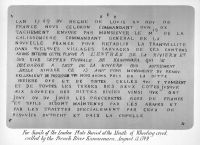
Leaden Plate Buried at Wheeling Creek
Pierre-Joseph Céloron de Blainville claims territory for France
In the mid-1700s, France and Great Britain stood on the brink of war for control of the Ohio Valley. In August of 1749, French Canadian military leader and explorer Pierre-Joseph Celoron, led by Native American guides, arrived at the mouth of Wheeling Creek with his Canadian militia. At the junction of Wheeling Creek and the Ohio River, he buried a leaden plate, claiming all territory drained by the streams in the name of Louis XV, king of France.
 Pictured here is a facsimile of the leaden plate (click on photo to enlarge) from the book, "History of the Pan Handle; Being Historical Collections of the Counties of Ohio, Brooke, Marshall and Hancock, West Virginia," published by J.A. Caldwell in 1879.
Pictured here is a facsimile of the leaden plate (click on photo to enlarge) from the book, "History of the Pan Handle; Being Historical Collections of the Counties of Ohio, Brooke, Marshall and Hancock, West Virginia," published by J.A. Caldwell in 1879.
The translation reads as follows:
"'In the year 1749, of the reign of Louis the 15th king of France, we Celoron, commander of a detachment sent by Monseur the Marquis de la Gallisoniere, Governor General of New France, to re-establish tranquility in some Indian villages of these cantons, have buried this Plate of Lead at the mouth and on the north bank of the river Kanououara, which empties into the easterly side of the Ohio river, otherwise Belle Riviere, this 13th day of August, as a monument of the renewal of the possession we have taken of the said river Ohio, and of all those which empty into it, and of all the lands on both sides as far as the sources of the said rivers, as enjoyed, or ought to have been enjoyed by the kings of France preceding, as they have there maintained themselves by arms and by treaties, especially those of Ryswick, Utrecht, and Aix fa Chapelle.'
"The royal arms were fixed, as usual, to a neighboring tree, and the memorial of the ceremony – the "Proces Verbal" – was duly drawn up and signed by the officers of the command in formal manner. After the performance of the ceremony, the expedition encamped for the night and remained until the next day."
The exact location of the leaden plate is today a mysytery. Even in 1879 when the book was written, there was already some debate.
"Owing to the great changes of time and the extensive filling of earth on the banks of the river and creek, it would be impossible at this day to definitely describe the exact resting place of this hidden treasure, but' it is fair to presume that it lies somewhere under the Baltimore & Ohio rail road depot, where once stood the" old barracks." The ruins of the old barracks are within the recollection of many old citizens of Wheeling, and the ground on which it stood, at the time of the expedition, was a feasible spot to bury one of the plates."
Additional Resources
Materials in the Library:
▶ "Civic Center Mural Dedication," Box 2, folder 4, Beverly Fluty papers, Archives, viewing by appointment only, call 304-232-0244.
Explorers | Events | Wheeling History Home | OCPL Home









 Want to keep up with all the latest Library news and events?
Want to keep up with all the latest Library news and events?